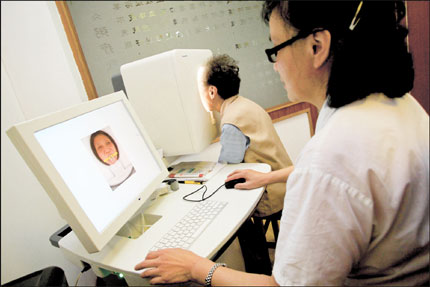
A doctor checks the picture taken by a TCM diagnostic equipment of the tongue of a patient who has her face scanned.
Today it's almost impossible to find a "100-percent pure" TCM doctor, and most accept the validity of some Western medicine, but modernizing and standardizing TCM itself remains controversial.
While Western medicine armed with its sophisticated diagnostic tools and high-tech equipment is developing rapidly, traditional Chinese medicine is still, well, traditional and very much hands-on.
To assess a person's condition, practitioners typically make a diagnosis by looking at the tongue, taking the pulse, listening to the breath, looking at the face and complexion, and, of course, asking questions.
These approaches have been used for more than a thousand years. Prescriptions mostly use herbs, sometimes animal parts and minerals. Acupuncture, acupressure and massage are also prescribed.
There is often no clear explanation for why a certain amount of a certain herb is prescribed and how it is supposed to work.
Therapies prescribed by different practitioners for the same ailment or for the same patient can vary considerably.
TCM practitioners - schooled in an entirely different medical approach rooted in Chinese philosophy - rely on extensive clinical experience as well as intuition to make their diagnosis and prescribe a course of treatment.
Here, we are not talking about infectious disease and serious conditions for which Western medicine is clearly indicated. TCM practitioners know when a patient needs to be hospitalized and needs antibiotics, for example.
Calls to modernize, quantify and standardize ancient TCM treatments have been heard for many years. And some efforts are underway, but the idea is still very controversial.
The idea of trying to modernize TCM was first raised in the mid-1990s.
One modernization approach in Shanghai involves the use of medical equipment. These include massage beds that simulate the massage by human hands, providing standard massage for relaxing neck, shoulders and back.
Computer-controlled acupuncture instruments accurately identify acupuncture points, insert needles to a prescribed depth and control the duration of treatment and strength of electric current.
Electromagnetic physiotherapy equipment is used to "dredge" energy meridians and collaterals, activate blood circulation, treat the kidneys and ovaries.
During the World Expo 2010 in Shanghai, a TCM diagnostic robot, developed by Shanghai University of Traditional Chinese Medicine and IT scientists, was demonstrated on volunteers. People simple sat in front of the machine, which recorded their breathing and pulse and took pictures of their tongues and faces.
Within seconds the robot captured basic physical information and compared it with its database of different pulse types, breathing, tongue conditions and complexions. The machine swiftly delivered a preliminary diagnosis. The system could potentially help patients far away, if the right photo, recording and communications equipment were available.
"Frankly, to modernize TCM or not is always a controversial issue, even today," says Dr Shang Li, director of the Shanghai Association of TCM International Exchange Center, a government-backed organization that promotes the TCM industry to the West.
"Western medicine and TCM are two entirely different systems. TCM was formed by millions of cases and the prescriptions were invented through doctors' rich clinical experiences," he says.
But Dr Shang is still positive about scientific development in TCM, which, he says, might be a great aid in promoting its understanding and acceptance in the West.
